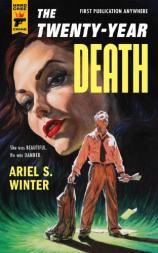The Twenty-Year Death
Review
The Twenty-Year Death
Sometimes a first novel appears that is so bold, so innovative, so brilliant that you just have to tip your hat and say “Bravo.” Such is the case with THE TWENTY-YEAR DEATH by Ariel S. Winter, a former bookseller and literary detective from Baltimore. First novel or 50th, this is a great book.
Hard Case Crime has made a habit of reprinting the works of great noir authors. Next month they will release a lost book from one of the masters of the genre, James M. Cain. But the publishing house and its editor, Charles Ardai, have also published the work of current and new authors whose original creations can keep the genre alive long into the 21st century.
THE TWENTY-YEAR DEATH works on every level. Start with the pulp cover painting by Charles Pyle. Hollywood star Rose McGowan served as a model. Her beautiful face looms over a man, who looks like a writer, seeking salvation or perhaps an escape from hell. The cover tells us: “She was BEAUTIFUL. He was DAMNED.”
"Sometimes a first novel appears that is so bold, so innovative, so brilliant that you just have to tip your hat and say “Bravo.” Such is the case with THE TWENTY-YEAR DEATH... Winter pulls no punches. Together, his three books add up to one transcendent breathtaking story you will not soon forget."
So we are firmly in the noir world. But closer inspection finds that the 670-page book is broken into three separate and self-contained novels. And each is written in a different writing style with Winter dedicating them to G.S., R.C. and J.T. True mystery fans will have fun with this clue in the bookstores and soon enough identify the initials as Georges Simenon, Raymond Chandler and Jim Thompson. The stories take place in 1931, 1941 and 1951, and each is written in the style of the respective author. The protagonist of the first book is a police inspector like Maigret; the second is a hard-boiled West Coast private eye like Marlowe; and the final one is the hellish first-person narrative of a trapped man and alcoholic.
This is ambitious indeed for a first novel, as if Winter decided to show up at Yankee Stadium determined to hit with Babe Ruth’s bat and belted a home run first time at the plate. For mystery fans, this is going to be like finding a lost book from your favorite author. And the true genius of Winter is that he has not written a novel full of clichés and recycled plots; the stories instead are original and engaging.
In a small French village, a man is found in a rainstorm dead in the street in front of the baker’s home. Chief Inspector Pelleter, with his ever-present cigar, is on the case. Complications ensue when it turns out the dead man was serving a long sentence in a nearby gothic French prison where nobody had ever escaped. His beautiful daughter, Clothilde, just happens to be staying in the village with her new husband, the famous American author Shem Rosenkrantz. The writer left his rich American wife and child to run off with his new young bride.
The first book is a classic roman noir, with Rosenkrantz playing a minor role. Book two flashes forward 10 years, and Chloe Rose is now a major film star in the fictional California city of San Angeles, SA, which bears a striking resemblance to Los Angeles. Clothilde is afraid somebody is after her, so the studio hires a PI, Dennis Foster, to go through the motions. But like Chandler’s famous creation, he sticks his nose in all the wrong places, keeps stumbling over bodies, gets beat up and makes enemies of the cops. But he also learns that Rosenkrantz is a writer approaching the skids, supposedly writing movies, but really involved with gangsters and pornography.
Foster is your classic cynical knight errant, complete with Marlowe-like observations. A man lies in the street where “he slept like a corpse at a wake.” But through Foster, Winter also gives us a good view of the Hollywood studio system during its Golden Age and restrictive Production Code. He writes, “Slap some film in the camera. Plug in some lights, pay a violinist or two to add background melodies, and presto, you’ve got yourself a product you can show at theaters around the country, or drive-ins if it isn’t good enough for the indoor crowd. Then do it again. Fifty times a year. A hundred. No slowdowns along the line. One part of the machinery is broken? Get another. Mr. and Mrs. America need their Sunday double feature, otherwise it would be nothing but newsreels, and we need morale to be high. Leave your dime at the door.”
By book three in 1951, both Inspector Pelleter and Foster have left the stage, and the story switches to Baltimore and is told by Rosenkrantz. It’s about as harrowing a view of alcoholism as I have seen in a long time. The writer’s true love and wife, Clothilde, is in a mental institution back west and the bills are due. He has returned to Baltimore to find out if his first wife left him any inheritance when she died and must painfully reconnect with the son he abandoned 20 years earlier. Rosenkrantz has reached the end of his tither. Winter writes, “There was a time when I just had to cable that I had a story written --- not the story itself, just that it was written --- and a magazine would cable $1,000 just like that, and that was during the Depression, too. But nobody would give me money now. They couldn’t even pretend it was an advance at this point. I hadn’t written a single sentence in years.”
And here is the greatness of THE TWENTY-YEAR DEATH. Winter has written a tribute to and history of hard-boiled, mid-20th-century American writing. He takes us on a tour of the genre, from the days when the dedicated cop solved every crime to the days when the cynical private eye goes down the mean streets but is not himself mean to the subversive truth of Jim Thompson. Sure, there is an American dream, Thompson told us, but there is an American nightmare as well, which can be a lot more dangerous. Winter writes, “In America, you got one chance, and if you hit it big then you hit it big, but if you fell, there was no climbing back up… There was no pretending. I was on my way out, not up.”
Winter pulls no punches. Together, his three books add up to one transcendent breathtaking story you will not soon forget. What a great job by Hard Case Crime for discovering this work and bringing it to the light of day. Winter has set the bar high for his next book. And that is something to look forward to.
Reviewed by Tom Callahan on August 17, 2012
The Twenty-Year Death
- Publication Date: August 7, 2012
- Genres: Fiction, Hard-boiled Mystery, Mystery, Suspense, Thriller
- Hardcover: 700 pages
- Publisher: Hard Case Crime
- ISBN-10: 0857685813
- ISBN-13: 9780857685810





